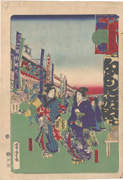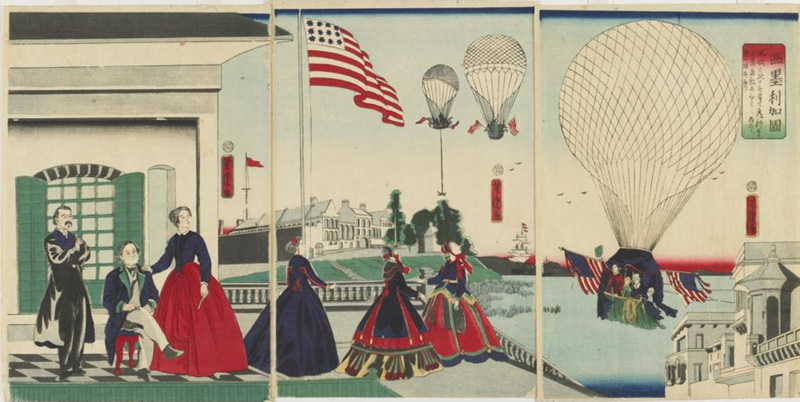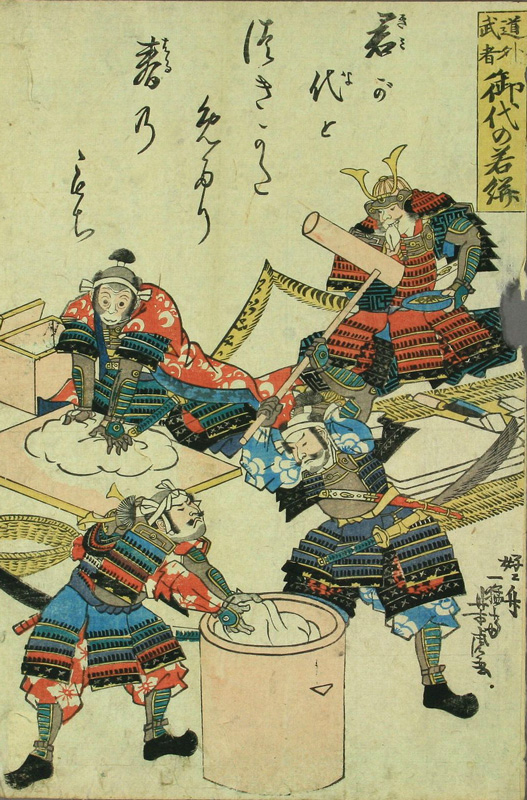Prints in Collection
The Great Virtue and Influence of the Inspiring Tenjin Sutra, 1859 IHL Cat. #1711 | 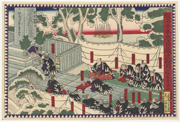 Act XII (Jūnidanme), from the series Act XII (Jūnidanme), from the seriesThe Storehouse of Loyal Retainers (Chūshingura), c. 1865 IHL Cat. #1790 |
| IHL Cat. #2368 | Steam Train at Takanawa Seashore, Tokyo, 1871 IHL Cat. #1175 |
Biographical Data
Original name: Nagashima; familiar name: Tatsugorō and later Tsunosuke, Tatsusaburō; gō: Ichimōsai 一猛斎 and Kinchōrō 錦朝楼, and Mōsai 孟斎 after 1874.1
Little is known of Yoshitora’s life, other than he was born and worked in Edo, became a pupil of Utagawa Kuniyoshi (1797-1861), changed addresses frequently in the late 1870s, and fell out of sight after 1882.
As an artist, Yoshitora was a prolific printmaker and illustrator whose work covered a broad range of subjects including warrior and war prints (musha-e and senso-e), “large-head” (okubi-e) actor portraits, prints of beautiful women (bijinga), prints of Japan’s modernization (kaika-e), humorous prints (giga) and, most famously, Yokohama-e, prints depicting Westerners and their technological advances, of which he designed over 150.2
Utagawa, Yoshitora, fl. 1850-1870
Amerikakoku, 1867
Japanese triptych print showing the American consul and several women watching the Japanese navy
test balloon aircraft in front of the American consulate in Tokyo, Japan.
Chadbourne collection of Japanese prints (Library of Congresshttp://www.loc.gov/pictures/item/2002700299/)
Amerikakoku, 1867
Japanese triptych print showing the American consul and several women watching the Japanese navy
test balloon aircraft in front of the American consulate in Tokyo, Japan.
Chadbourne collection of Japanese prints (Library of Congresshttp://www.loc.gov/pictures/item/2002700299/)
His earliest known work, illustrations in the book Story of Karasu Kanzaemon’s Loyalty (Karasu Kanzaemon chugi den), dates from 1836 and his first print series dates to the early 1840s.3 Throughout his career Yoshitora collaborated with other artists on various prints and print series, such as his work with Utagawa Yoshiiku (1833-1904) and Kawanabe Kyōsai (1831-1889) on Famous Views of Modern Tokyo (Tokyo kaika meisho no uchi), 1873 and Utagawa Kunisada I's (1786–1865) so-called “Kinshodo Edition of Large-Head Actor Portraits” (Kinshodo-ban yakusha okubi-e).4
Yoshitora (top left) fighting with his fellow student Yoshikizu (act. c. 1848-1870) in Kuniyoshi's studio as drawn by Kawanabe Kyosai in his Kyosai Gadan (Kyosai’s Conversations on Painting), volume 3, 1887. This is the only known rendering of Yoshitora. | Yoshitora was considered one of Kuniyoshi’s best pupils and was ranked as high as second best in the "ranking list of nishiki-e artists" in 1868, after Utagawa Sadahide (1807-1873).5 After his brush with the law (see “Censorship and Handcuffs” below) it is reported that he was “expelled from Kuniyoshi’s studio.”6 Writing in 1922, at a time when the view of late Edo and Meiji prints was generally negative, the English collector Basil Stewart wrote: “Of these [Kuiyoshi’s pupils] Yoshitora (w. 1850) was, perhaps, one of the best, his colours being as a rule less offensive than is generally the case with prints of this date.”7 During the Meiji era (starting 1867) Yoshitora worked as a newspaper journalist and in the early 1880s most of his work was as a book illustrator. One of the few students he had, Yoshi (aka Horiyoshi), became a tattoo artist.8 |
Various restrictions on print content and publishing were put in place by the bakufu during the 1840s and “[i]n 1843, Eisen, Hiroshige, Utagawa Kunisada, Utagawa Kuniyoshi (1797-1861), Utagawa Sadahide (1807-73) and Utagawa Yoshitora (act. C. 1830s-1880s) gave a joint written undertaking to the bakufu not to produce any unacceptable prints, which is some indication of the oppressive atmosphere of the times.”9 Despite the above assurances, Yoshitora ran afoul of the authorities in 1849 for satirizing shogun Tokugawa Ieyasu (1543-1616; r. 1603-05) in his print Funny Warriors-Our Ruler’s New Year’s Rice Cakes (Doke musha: miyo no wakamochi) and was sentenced to 50 days in handcuffs.10
Sample Signatures and Seals of the Artist
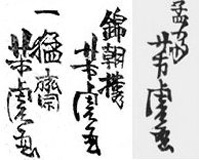 Source: wikipedia |  一猛斎芳虎画Ichimōsai Yoshitora ga (1871) |  Yoshitora ga |  一猛斎芳虎画 Ichimōsai Yoshitora ga |  孟斎芳虎拝畫 Mōsai Yoshitora haiga |  Kinchōrō Yoshitora ga |
2 "Yokohama-e," Helen Merritt and Oikawa Shigeru, appearing in the The Hotei Encyclopedia of Japanese Woodblock Prints, Amy Reigle Newland, Hotei Publishing Company, 2005, p. 266.
3 Japanese Woodblock Prints: Artists, Publishers and Masterworks 1680-1900, Andreas Marks, Tuttle Publishing, 2010, p. 146.
4 ibid.
5 ibid.
6 ibid.
7 A Guide to Japanese Prints and Their Subject Matter, Basil Stewart, Dover Publications, Inc., 1979, p. 56.
8 op cit., Marks
9 "The Publishing Trade," P.F. Kornicki, appearing in the The Hotei Encyclopedia of Japanese Woodblock Prints, Amy Reigle Newland, Hotei Publishing Company, 2005, p. 312.
10 The Hotei Encyclopedia of Japanese Woodblock Prints, Amy Reigle Newland, Hotei Publishing Company, 2005, Hotei Encyclopedia, p. 505.


